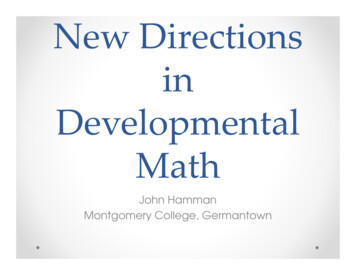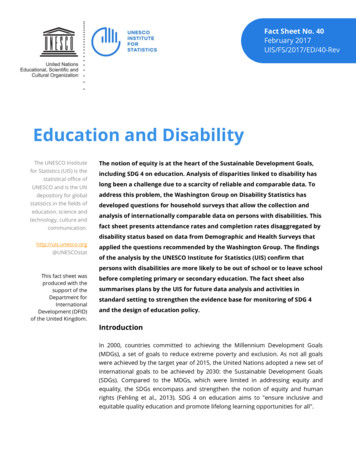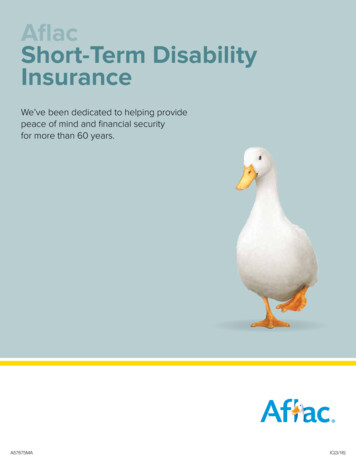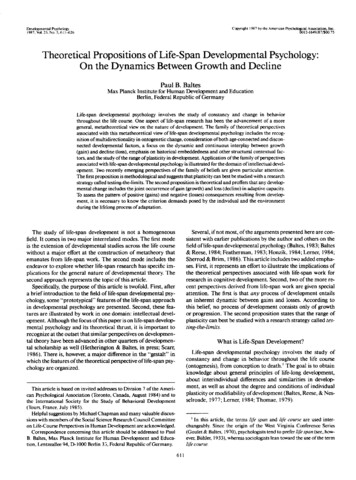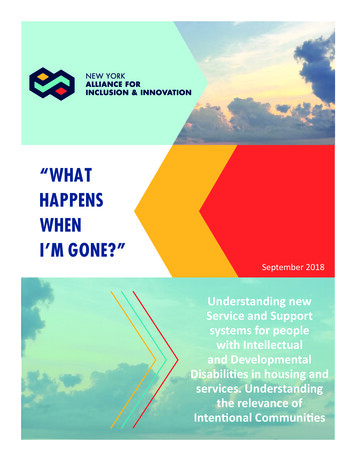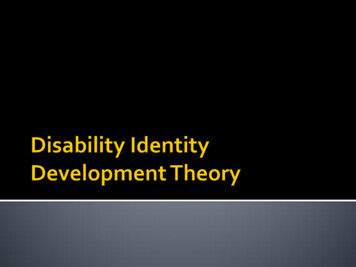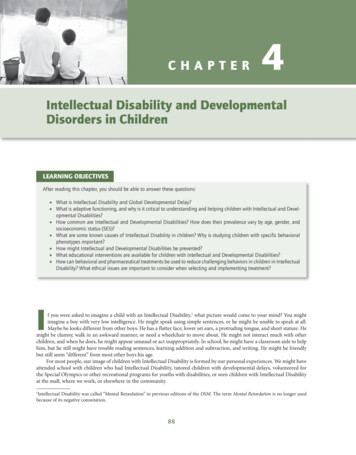
Transcription
CHAPTER4Intellectual Disability and DevelopmentalDisorders in ChildrenLEARNING OBJECTIVESAfter reading this chapter, you should be able to answer these questions: What is Intellectual Disability and Global Developmental Delay? What is adaptive functioning, and why is it critical to understanding and helping children with Intellectual and Developmental Disabilities? How common are Intellectual and Developmental Disabilities? How does their prevalence vary by age, gender, andsocioeconomic status (SES)? What are some known causes of Intellectual Disability in children? Why is studying children with specific behavioralphenotypes important? How might Intellectual and Developmental Disabilities be prevented? What educational interventions are available for children with Intellectual and Developmental Disabilities? How can behavioral and pharmaceutical treatments be used to reduce challenging behaviors in children in IntellectualDisability? What ethical issues are important to consider when selecting and implementing treatment?If you were asked to imagine a child with an Intellectual Disability,1 what picture would come to your mind? You mightimagine a boy with very low intelligence. He might speak using simple sentences, or he might be unable to speak at all.Maybe he looks different from other boys: He has a flatter face, lower set ears, a protruding tongue, and short stature. Hemight be clumsy, walk in an awkward manner, or need a wheelchair to move about. He might not interact much with otherchildren, and when he does, he might appear unusual or act inappropriately. In school, he might have a classroom aide to helphim, but he still might have trouble reading sentences, learning addition and subtraction, and writing. He might be friendlybut still seem “different” from most other boys his age.For most people, our image of children with Intellectual Disability is formed by our personal experiences. We might haveattended school with children who had Intellectual Disability, tutored children with developmental delays, volunteered forthe Special Olympics or other recreational programs for youths with disabilities, or seen children with Intellectual Disabilityat the mall, where we work, or elsewhere in the community.1Intellectual Disability was called “Mental Retardation” in previous editions of the DSM. The term Mental Retardation is no longer usedbecause of its negative connotation.88
CASE STUDYDONTRELL: A FRIENDLY BOYDontrell was a 5-year-old African American boy referred to our clinic by his pediatrician. Dontrell showed delays in understanding language, speaking, and performing daily tasks. His mother had used alcohol and other drugs during pregnancy. Shedid not receive prenatal care because she was afraid that an obstetrician would report her drug use to the police. Dontrellwas born with various drugs in his system and had respiratory and cardiovascular problems at birth. Shortly after delivery,Dontrell’s mother disappeared, leaving him in his grandmother’s care.Dontrell was slow to reach many developmental milestones. Whereas most children learn to sit up by age 6 months andwalk by their first birthday, Dontrell showed delays mastering each of these developmental tasks. Most striking were Dontrell’smarked delays in language. Although he could understand and obey simple commands, he was able to speak only 15 to 20words, and many of these were difficult to understand. He could not identify colors, was unable to recite the alphabet, andcould not count. He also had problems performing self-care tasks typical of children his age. For example, he could not dresshimself, wash his face, brush his teeth, or eat with utensils.Dontrell showed significant problems with his behavior. First, he was hyperactive and inattentive. Second, Dontrell showedserious problems with defiance and aggression. When he did not get his way, he would tantrum and throw objects. He wouldalso hit, kick, and bite other children and adults when he became upset. Third, Dontrell’s grandmother said that he had “anobsession for food.” Dontrell apparently had an insatiable appetite and was even caught hoarding food under his bed andstealing food from relatives.Dr. Valencia, the psychologist who performed the evaluation, was most struck by Dontrell’s appearance. Although only 5years old, Dontrell weighed almost 85 lbs. He approached Dr. Valencia with a scowl and icy stare. Dr. Valencia extended herhand and said, “Hello.” Dontrell grabbed Dr. Valencia’s hand and kissed it! His grandmother quickly apologized, responding,“Sorry . . . he does that sometimes. He’s showing that he likes you.”Although our image of Intellectual Disability, generatedfrom these experiences, might be accurate, it is probably notcomplete. Intellectual Disability is a term that describes anextremely diverse group of people. They range from childrenwith severe developmental disabilities who need constant careto youths with only mild delays who are usually indistinguishable from others (Hodapp, Zakemi, Rosner, & Dykens, 2006).WHAT IS INTELLECTUALDISABILITY?The DSM-5 Definitionof Intellectual DisabilityAccording to the DSM-5, Intellectual Disability is characterized by significant limitations in general mentalTable 4.1abilities and adaptive functioning that emerge during thecourse of children’s development. Limitations must beevident in comparison to other people of the same age,gender, and social-cultural background. (See Table 4.1,Diagnostic Criteria for Intellectual Disability [IntellectualDevelopmental Disorder].)All individuals with Intellectual Disability must showsignificantly low intellectual functioning. These individualsshow problems perceiving and processing new information, learning quickly and efficiently, applying knowledgeand skills to solve novel problems, thinking creatively andflexibly, and responding rapidly and accurately. In children approximately five years of age and older, intellectualfunctioning is measured using a standardized, individuallyadministered intelligence test. IQ scores are normally distributed with a mean of 100 and a standard deviation of 15.IQ scores approximately two standard deviations below the Diagnostic Criteria for Intellectual Disability (Intellectual Developmental Disorder)Intellectual disability (intellectual developmental disorder) is a disorder with onset during the developmental period that includesboth intellectual and adaptive functioning deficits in conceptual, social, and practical domains. The following three criteria mustbe met:A. Deficits in intellectual functions, such as reasoning, problem solving, planning, abstract thinking, judgment, academiclearning, and learning from experience, confirmed by both clinical assessment and individualized, standardizedintelligence testing.(Continued)CH APT ER 4 I N TE LLE C TUA L D I S A B I LI T Y A ND DEVELOPM ENTA L DI SORDERS I N CHI LDREN89
Table 4.1 (Continued)B. Deficits in adaptive functioning that result in failure to meet developmental and socio-cultural standards for personalindependence and social responsibility. Without ongoing support, the adaptive deficits limit functioning in one or moreactivities of daily life, such as communication, social participation, and independent living, across multiple environments,such as home, work, and community.C. Onset of intellectual and adaptive deficits during the developmental period.Specify current severity: Mild, Moderate, Severe, Profound*Source: Reprinted with permission from the Diagnostic and Statistical Manual of Mental Disorders, Fifth Edition, (Copyright 2013). American PsychiatricAssociation.* Table 4.2 provides a description of each type of severity.mean (i.e., IQ 70) can indicate significant deficits in intellectual functioning. The measurement error of most IQ testsis approximately 5 points; consequently, IQ scores between65 and 75 are recommended as cutoffs in determining intellectual deficits (American Psychiatric Association, 2013). IQscores below this cutoff are seen in approximately 2.5–3.0%of the population (Durand & Christodulu, 2006).Second, individuals with Intellectual Disability show significant deficits in adaptive functioning. Adaptive functioningrefers to how effectively individuals cope with common lifedemands and how well they meet the standards of personalindependence expected of someone in their particular agegroup, social-cultural background, and community setting(American Psychiatric Association, 2013). Whereas intellectual functioning refers to people’s ability to learn information and solve problems, adaptive functioning refers to theirtypical level of success in meeting the day-to-day demands ofsociety in an age-appropriate manner.DSM-IV DSM-5 CHANGESA DIAGNOSIS BY ANY OTHER NAMEThere has been considerable controversy regarding the name of the disorder “Intellectual Disability.” In DSM-IV, thisdisorder was called “Mental Retardation” to reflect the below-average intellectual ability of individuals with this condition. However, the developers of DSM-5 agreed to abandon this term because of its negative connotation. When revisingDSM-IV, the American Psychiatric Association’s Neurodevelopmental Disorders working group considered renaming thedisorder “Intellectual Developmental Disorder.” Their proposal drew considerable criticism from the leading professionalorganization of individuals who work with people with developmental disabilities, the American Association of Intellectualand Developmental Disabilities (AAIDD; Gomez & Nygren, 2012). Instead, The AAIDD argued that the name “IntellectualDisability” (not Developmental) be adopted in DSM-5 for several reasons: Intellectual Disability is the most commonly used term in the United States and internationally to refer to people with intellectualand adaptive skills deficits. The term reflects the World Health Organization’s conceptualization of low intelligence and adaptive functioning as a “disability.” It implies deficits in both intelligence and adaptive functioning, not only low IQ. It is less offensive than the often pejorative term Mental Retardation.In 2010, Rosa’s Law (PL 111-256) replaced the term Mental Retardation with Intellectual Disability in federal education,health, and labor laws. The law was named after 9-year-old Rosa Marcellino, a girl with Down Syndrome, whose familyworked to have the term retardation removed from the educational code in her home state of Maryland.The APA decided to adopt the term Intellectual Disability in DSM-5 yet retains the term Intellectual DevelopmentalDisorder in parentheses.90PAR T II DEVELOPM ENTA L A ND LEA RNI NG DIS ORD ERS
DSM-5 identifies three domains of adaptive functioning: conceptual, social, and practical. These domains wereidentified by using a statistical procedure called factor analysis to determine groups of skills that tend to co-occur inindividuals with developmental disabilities. To be diagnosedwith Intellectual Disability, individuals must show impairment in at least one domain. Usually, children with Intellectual Disability experience problems in multiple areas: Conceptual skills: understanding language, speaking, reading, writing, counting, telling time, solving math problems,the ability to learn and remember information and skills Social skills: interpersonal skills (e.g., making eye contactwhen addressing others), following rules (e.g., turn-takingduring games), social problem-solving (e.g., avoiding arguments), understanding others (e.g., empathy), making andkeeping friends Practical skills: activities of daily living including personalcare (e.g., getting dressed, grooming), safety (e.g., lookingboth ways before crossing street), home activities (e.g.,using the telephone), school/work skills (e.g., showing upon time), recreational activities (e.g., clubs, hobbies), andusing money (e.g., paying for items at a store)Adaptive functioning can be assessed by interviewingcaregivers about children’s behavior and comparing theirreports to the behavior of typically developing children ofthe same age and cultural group (Tassé et al., 2012).Often, psychologists administer a norm-referencedinterview or rating scale to caregivers to collect information about children’s functioning. For example, theDiagnostic Adaptive Behavior Scale (DABS) is a semistructured interview that is administered to caregiversof children with developmental disabilities. Based oncaregivers’ reports, the interviewer rates children’s adaptive behavior across the conceptual, social, and practicaldomains (see text box Research to Practice: AdaptiveFunctioning Examples). The DABS provides standardscores much like IQ scores, which indicate children’s adaptive functioning relative to their peers. Scores more thantwo standard deviations below the mean (i.e., 70) on atleast one domain could indicate significant impairment inadaptive functioning (Tassé et al., 2011).It is important to keep in mind that Intellectual Disability is characterized by low intellectual functioning andproblems in adaptive behavior. Many people believe thatIntellectual Disability is determined solely by IQ; however,deficits in adaptive functioning are equally necessary for thediagnosis. A child with an IQ of 65 but with no problemsin adaptive functioning would not be diagnosed with Intellectual Disability.RESEARCH TO PRACTICEADAPTIVE FUNCTIONING EXAMPLESClinicians assess adaptive functioning by administering semi-structured interviewers to caregivers of children suspected ofIntellectual Disability. Adaptive functioning scales allow clinicians to assess children’s conceptual, social, and practical skills.Caregivers’ reports are converted to standard scores which can be used to determine if children have deficits compared toother children their age in the general population. Below are some areas of adaptive functioning that might be assessedin younger children, older children, and adolescents.Younger ChildrenOlder ChildrenAdolescentsConceptualCan count 10 objects, oneby one;Knows day, month, year ofbirthStates value of penny, nickel, dime;Uses mathematical operationsSets a watch or clock to correcttime;Can complete a jobapplicationSocialSays “hi” and “bye” whencoming and going;Asks for help when neededReads and obeys common signs (e.g., stop, donot enter);Knows topic of group conversationsHas satisfying friendships;Keeps personal informationprivatePracticalUses the restroom; Drinksfrom a cup without spillingAnswers the telephone;Can safely cross busy streetsTravels to school or work bythemselves;Washes clothes, dishesCH APT ER 4 I N TE LLE C TUA L D I S A B I LI T Y A ND DEVELOPM ENTA L DI SORDERS I N CHI LDREN91
Finally, all individuals with Intellectual Disability showlimitations in intellectual and adaptive functioning early in life.Although some people are not identified as having IntellectualDisability until they are adults, they must have histories ofintellectual and daily living problems beginning in childhood.This age-of-onset requirement differentiates Intellectual Disability from other disorders characterized by problems withintellectual and adaptive functioning, such as Alzheimer’sDementia (i.e., cognitive deterioration seen in older adults).Severity of ImpairmentIn the past, children with Intellectual Disability were categorized into one of four subtypes based on their IQ. This practicewas abandoned in DSM-5 for three reasons. First, the developers of DSM-5 wanted to give equal importance to IQ andadaptive functioning in describing children with IntellectualDisability, rather than focus exclusively on IQ alone. Second,Table 4.2children’s IQ scores were less helpful than their level of adaptivebehavior in determining their need for support and assistanceat home, at school, and in the community. Third, IQ scores tendto be less valid toward the lower end of the IQ range.Consequently, in DSM-5, clinicians specify the severity ofIntellectual Disability based on the person’s level of adaptivefunctioning. Adaptive functioning can be assessed using standardized rating scales, clinical interviews, and observationsat home and school. Children with mild deficits in adaptivefunctioning (i.e., standard scores 55–70) in only one domainwould presumably need less support from caregivers thanchildren with profound deficits in adaptive functioning (i.e.,standard scores 25) across multiple domains. Furthermore,by specifying the domains most in need of support, clinicianscan begin to plan interventions to improve children’s adaptive functioning or compensate for deficits that might be lessresponsive to treatment. Table 4.2 provides a general overviewof children’s adaptive functioning at each level of severity. Describing the Severity of Intellectual DisabilitySeverityConceptual DomainSocial DomainPractical DomainMildPreschoolers may show no obviousconceptual differences. School-agedchildren show difficulties in acquiringacademic skills (e.g., reading, writing,arithmetic, telling time, using money).Abstract thinking and planning may beimpaired; thinking tends to be concrete.Communication, conversation, andlanguage are more concrete or immaturethan the skills of peers. The child mayhave difficulty accurately understandingthe social cues of others.The child may function in anage-expected manner with regardto personal care. In adolescence,assistance may be needed to performmore complex daily living tasks likeshopping, cooking, and managingmoney.There may be difficulties regulatingemotion and behavior compared to peers.Moderate Preschoolers’ language and preacademic skills develop slowly.School-age children show slowprogress in academic skills. Academicskill development is usually at theelementary school level.The child shows marked differencesin social and communicative skillscompared to peers.SevereThe child generally has littleunderstanding of written language ornumbers. Caretakers must provideextensive support for problem solvingthroughout life.There are limited spoken language skillswith simplistic vocabulary and grammar.Speech may be single words/phrases.The child understands simple speech andgestures. Relationships are with familymembers and other familiar people.The child needs ongoing support forall activities of daily living: eating,dressing, bathing, elimination.Caregivers must supervise at alltimes. Some youths show challengingbehaviors, such as self-injury.ProfoundConceptual skills generally involve thephysical world rather than symbols(e.g., letters, numbers). Some visualspatial skills, such as matching andsorting, may be acquired with practice.Co-occurring physical problems maygreatly limit functioning.The child has limited understanding ofsymbolic communication. The child mayunderstand some simple instructionsand gestures. Communication is usuallythrough nonverbal, non-symbolic means.Relationships are usually with familymembers and other familiar people.Co-occurring physical problems maygreatly limit functioning.The child is dependent on others forall aspects of physical care, health,and safety, although he or she mayparticipate in some aspects of selfcare. Some youths show challengingbehaviors, such as self-injury.Co-occurring physical problems maygreatly limit functioning.Spoken language is simplistic andconcrete.Social judgment and decision making arelimited. Friendships with peers are oftenaffected by social or communicativedeficits.The child needs more time andpractice learning self-care skills, suchas eating, dressing, toileting, andhygiene, than peers. Household skillscan be acquired by adolescent withample practice.Source: Based on DSM-5, 2013.92PAR T II DEVELOPM ENTA L A ND LEA RNI NG DIS ORD ERS
Mild Intellectual Disability (AdaptiveFunctioning Scores 55–70)As infants and toddlers, children with mild IntellectualDisability usually appear no different than other children(Jacobson & Mulick, 1996). They achieve most developmentalmilestones at expected ages, learn basic language, and interactwith family members and peers. Their intellectual deficits areusually first identified when they begin school. Teachers maynotice that they require more time and practice to master academic skills, such as letter and number recognition, reading,and math. As they progress in school and their schoolworkbecomes more challenging, these children fall further behindand may repeat a grade. Some children grow frustrated withtraditional education and display behavior problems inclass. By middle school, these children master basic reading and math but seldom make further academic progress.After school, they typically blend back into society, performsemiskilled jobs, and live independently in the community.They usually require only occasional support from others toovercome their intellectual deficits. For example, they mayneed help completing a job application, filing a tax return, ormanaging their finances.Moderate Intellectual Disability(Adaptive Functioning Scores 40–55)Children with moderate Intellectual Disability often showsigns of their intellectual and adaptive impairments as infantsor toddlers (Jacobson & Mulick, 1996). Their motor skillsusually develop in a typical fashion, but parents often noticedelays in learning to speak and interacting with others. Thesechildren often seem less interested in their surroundingscompared to their age mates. They are often first identifiedas having Intellectual Disability as toddlers or preschoolers,when they show little or no language development. Instead,they rely mostly on gestures and single word utterances. Bythe time they begin school, these children usually speak inshort, simple phrases and show self-care skills similar totypically developing toddlers. However, they display problemsmastering basic reading, writing, and mathematics. By adolescence, these children are able to communicate effectivelywith others, have basic self-care skills, and have simple reading and writing abilities. They may continue to have troublewith reading a newspaper, performing arithmetic, or handlingmoney. As adults, some may perform unskilled jobs if they aregiven training and supervision. They usually live with familymembers or in residential care facilities.Severe Intellectual Disability(Adaptive Functioning Scores 25–40)Children with severe Intellectual Disability are usually firstidentified in infancy (Jacobson & Mulick, 1996). They almostalways show early delays in basic developmental milestones,such as sitting up and walking. They also usually show one ormore biological anomalies that are indicative of a genetic ormedical disorder. These children often have health problems,are at risk for long-term motor disorders, or have seizures.They require ample supervision from parents and caregivers.By the time they begin school, they may be able to move ontheir own and perform some basic self-care skills, such asfeeding, dressing, and using the toilet. They may communicate using single words and gestures. As adults, their speechcontinues to be limited and difficult to understand, althoughtheir ability to understand others is often better developed.They are usually unable to read or write, but they may be ableto perform simple daily living tasks under close supervision.They typically live with family or in residential care.Profound Intellectual Disability(Adaptive Functioning Scores 25)Children with profound Intellectual Disability are firstidentified in infancy (Jacobson & Mulick, 1996). Theyalmost always show multiple biological anomalies andhealth problems indicative of neurological damage. By thetime they reach school age, their skills are similar to thoseof typically developing one-year-olds. They may be able tosit up, imitate sounds, understand simple commands, andrecognize familiar people. About half of the children withprofound Intellectual Disability will continue to require helpfrom others throughout their lives. The other half will showslow development of adaptive skills. They may learn to walk,develop some communication skills, and be able to performsome self-care activities. As adults, they usually continue torequire constant support and supervision from family andcaregivers. They may also show chronic medical problemsand sensory impairments.Remember that the diagnosis of Intellectual Disabilityis determined by the child’s intelligence and adaptive functioning. Two people can show Intellectual Disability but lookand act very differently. For example, one person might be achild with Down Syndrome. Another child with the same IQmight have no identifiable cause of their impairments. Thelabel “Intellectual Disability” tells us only about a person’sgeneral intellectual and adaptive functioning; the diagnosissays nothing about etiology, symptoms, course, or outcomes(Baumeister & Bacharach, 2000).The AAIDD Definitionof Intellectual DisabilityThe American Association on Intellectual and Develop mentalDisabilities (AAIDD) is the oldest professional organizationdevoted to the study and assistance of individuals with impairments in intellectual and adaptive functioning. The AAIDDconsists of professionals and laypersons who research, help,and advocate on behalf of people with intellectual disabilities.Since 1910, they have offered guidelines for the identification ofIntellectual Disability and the best methods to help children andCH APT ER 4 I N TE LLE C TUA L D I S A B I LI T Y A ND DEVELOPM ENTA L DI SORDERS I N CHI LDREN93
adults with this condition. In years past, the DSM and AAIDDdefinitions of Intellectual Disability had differed considerably.Currently, however, the DSM-5 and AAIDD definitions overlapconsiderably, which will likely improve communication betweenmembers of these two professional organizations (Schalocket al., 2010).One difference in the AAIDD conceptualization of Intellectual Disability is its emphasis on needed supports (Luckasson et al., 2002). Needed supports refer to a broad arrayof assistance that helps the individual function effectivelyin society. Supports can be formal assistance provided byhealth care providers, mental health professionals, teachers,educational specialists, professional caregivers, or humanservice agencies. Supports can also refer to informal helpfrom parents, friends, or members of the community. TheAAIDD designates four possible levels of supports, based onhow much and how long assistance is needed: intermittent(i.e., occasional, in time of crisis), limited (i.e., short-term),extensive (i.e., long-term), and pervasive (i.e., constant).Rather than categorize clients into mild, moderate,severe, and profound impairment, the AAIDD recommendsthat professionals describe individuals’ need for supportsacross various areas of functioning. For example, a child withIntellectual Disability might be described as needing “extensive” educational support, such as a full-time classroom aide,for all academic activities, but only “intermittent” support inareas of social functioning, such as one-time training to helphim learn to make friends.The AAIDD has published a semi-structured interviewto help clinicians identify the type and intensity of supportsneeded for adolescents and adults with Intellectual Disability(Schalock et al., 2008). The Supports Intensity Scale measuressupport needs in the areas of home living, community living, lifelong learning, employment, health and safety, socialactivities, and protection and advocacy. It ranks each activityaccording to frequency (e.g., none, at least once a month),amount (e.g., none, less than 30 minutes), and type (e.g.,monitoring, verbal gesturing) of support needed.The AAIDD’s approach to classifying individuals withIntellectual Disability in terms of needed supports has twomain advantages (Schalock et al., 2008). First, this approachconveys more information about clients than simply classifying them with Intellectual Disability alone. Second, it focuseson clients’ abilities rather than on their impairments. Themain drawback to the AAIDD approach is that it is complex.Describing clients on so many dimensions of functioning iscumbersome and can hinder communication among professionals. The AAIDD approach can also make research difficult; with so many combinations of needed supports andareas of functioning, it is difficult to identify homogenousgroups of individuals for study.WHAT IS GLOBALDEVELOPMENTAL DELAY?Definition and DescriptionThe diagnosis of Intellectual Disability requires significantdeficits in intellectual functioning and adaptive skills.Typically, intellectual functioning is assessed using normreferenced IQ tests. However, it is difficult to obtain an IQImage 4.1 The AAIDD conceptualization ofIntellectual Disability emphasizes needed supports— assistance from others that helps the person with adisability function effectively in society.Source: Courtesy of Kiona Miller.94PAR T II DEVELOPM ENTA L A ND LEA RNI NG DIS ORD ERS
score for very young children. Some tests can be administered to very young children. For example, the WechslerPreschool and Primary Scales of Intelligence Fourth Edition(WPPSI-IV) can be given to children as young as 2 and ahalf years, whereas the Bayley Scales of Infant and ToddlerDevelopment Third Edition (BSID-III) is appropriate forchildren aged 1 to 42 months. However, these tests are usually considered measures of children’s cognitive, motor, andsocial development rather than intelligence per se.The most commonly used intelligence test, the WechslerIntelligence Scale for Children, Fourth Edition (WISC-IV),can only be administered to children 6 years old or older.Other true IQ tests, like the Stanford-Binet IntelligenceScales Fifth Edition (SB-5), can be administered to 2-year-oldchildren. However, IQ determined prior to age 4 or 5 years isa poor predictor of IQ in childhood or adolescence (Tirosch& Jaffe, 2011). How, then, should infants and toddlers withdelays be classified?Global Developmental Delay (GDD) is a neurodevelopmental disability that is only diagnosed in childrenless than 5 years of age.
activities of daily life, such as communication, social participation, and independent living, across multiple environments, such as home, work, and community. C. Onset of intellectual and adaptive deficits during the developmental period. Specify cu

